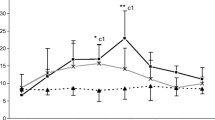Summary
In dermatophytosis, there is exocytosis of polymorphonuclear leukocytes (PMNs) toward the fungus-laden horny layer. To analyze this mechanism, we studied in vitro leukotactic properties of epidermal extracts prepared from lesions of experimental Trichophyton mentagrophytes infection in guinea pigs as well as fungus-derived chemotactic factors. Trichophyton mentagrophytes was found to release low-molecular-weight PMN chemotactic factors with its growth, like other microorganisms. Furthermore, it activated complement via the alternative pathway to produce complement-derived chemotactic factors in vitro. The epidermal extracts prepared from weakly inflammatory lesions of an early stage of T. mentagrophytes infection showed mild PMN chemotactic activity, which, as in those from irritated skin, was mostly due to the presence of low-molecular-weight chemotactic factors. After 8 days of infection, when prominent PMN migration took place together with the development of immune reactivity to fungus antigens, the epidermal extracts revealed strong leukotactic activity that showed a triphasic pattern by Sephadex G-75 chromatography similar to that observed in complement-activated serum. Since we could not demonstrate any deposition of immunoglobulins and complement on the fungal elements present in the horny layer, actual complement activation in vivo seems to occur after interaction of serum with soluble fungal components in the epidermis through both classic and alternative pathways. We think that the transepidermal migration of PMNs in dermatophytosis, together with contact sensitivity to fungal antigens, is responsible for induction of increased epidermopoiesis with resultant desquamation to eliminate the fungus-laden horny layer.
Similar content being viewed by others
References
Ackerman AB (1979) Subtle clues to diagnosis by conventional microscopy. Neutrophils within the cornified layer as clues to infection by superficial fungi. Am J Dermatopathol 1:69–75
Berk SH, Penneys NS, Weinstein GD (1976) Epideraml activity in annular dermatophytosis. Arch Dermatol 112:485–488
Calich VLG, Kipnis TL, Mariano M, Neto CF, Dias Da Silva W (1979) The activation of the complement system by Paracoccidioides brasiliensis in vitro: Its opsonic effect and possible significance for an in vitro model of infection. Clin Immunol Immunopathol 12:20–30
Cutler JE (1977) Chemotactic factor produced by Candida albicans. Infect Immun 18:568–573
De la Brassinne M, Lachapelle JM (1976) Epidermal and dermal cell renewal in pustular psoriatic erythroderma. In: Farber EM, Cox AJ, Jacobs PH, Nall ML (eds) Psoriasis. Proceedings of the Second International Symposium. Yorke Medical Books, New York, pp 368–370
Diamond RD, May JE, Kane MA, Frank MM, Bennett JE (1976) The role of the classical and alternate complement pathways in host defenses against Cryptococcus neoformans infection. J Immunol 112:2260–2270
Galgiani JN, Isenberg RA, Sevens DA (1978) Chemotaxigenic activity of extracts from mycelial and spherule phases of Coccidioides immitis for human polymorphonuclear leukocytes. Infect Immun 21:862–865
Green F III, Balish E (1979) Suppression of in vitro lymphocyte transformation during an experimental dermatophyte infection. Infect Immun 26:554–562
Jensen JA, Esquenzazi V (1975) Chemotactic stimulation by cell surface immune reactions. Nature 256:213–215
Jones HE, Reinhardt JH, Rinaldi MG (1975) Model dermatophytosis in naturally infected subjects. Arch Dermatol 110:363–374
Kerbs S, Greenberg J, Jesrani K (1977) Temporal correlation of lymphocyte blastogenesis, skin test responses and erythema during dermatophyte infection. Clin Exp Immunol 27:526–530
Levine N, Hatcher VB, Lazarus GS (1976) Proteinases of human epidermis: A possible mechanism for polymorphonuclear leukocyte chemotaxis. Biochem Biophys Acta 452:458–467
Maibach HI, Kligman AM (1976) The biology of experimental human cutaneous moniliasis (Candida albicans). Arch Dermatol 85:233–254
Ray TL, Wuepper KD (1976) Activation of the alternative (properdin) pathway of complement by Candida albicans and related species. J Invest Dermatol 67:700–703
Ray TL, Wuepper KD (1978) Experimental cutaneous candidiasis in rodents. II. Role of the stratum corneum barrier and serum complement as a mediator of a protective inflammatory response. Arch Dermatol 114:539–543
Shiffman E, Showell HV, Corcoran BA, Ward PA, Smith E, Becker EL (1975) The isolation and partial characterization of neutrophil chemotactic factors from Escherichia coli. J Immunol 114:1831–1837
Sohnle PG, Frank MM, Kirkpatrich CH (1976) Mechanisms involved in elimination of organisms from experimental cutaneous Candida albicans infections in guinea pigs. J Immunol 117:523–530
Soltani K, Van Scott EJ (1972) Patterns and sequence of tissue changes in incipient and evolving lesions of psoriasis. Arch Dermatol 106:484–490
Tagami H, Watanabe S, Ofuji S (1974) Trichophytin contact sensitivity in guinea pigs with experimental dermatophytosis induced by an new inoculation method. J Invest Dermatol 61:237–241
Tagami H, Watanabe S, Ofuji S, Minami K (1977) Trichophytin contact sensitivity in patients with dermatophytosis. Arch Dermatol 113:1409–1414
Tagami H, Ofuji S (1978) A leukotactic factor in the stratum corneum of pustulosis plamaris et plantaris: A possible mechanism for the formation of intra-epidermal sterile pustules. Acta Derm Venereol (Stockh) 58:401–405
Ward PA, Lepow IH, Newman LJ (1968) Bacterial factors chemotactic for polymorphonuclear leukocytes. Am J Pathol 52:725–736
Ward PA, Hill JH (1970) C5 chemotactic fragments produced by an enzyme in lysosomal granules of neutrophils. J Immunol 104:535–543
Ward PA, Chapitis J, Conroy MC, Lepow IH (1973) Generation by bacterial proteinases of leukotactic factors from human serum and human C3 and C5. J Immunol 110:1003–1009
Author information
Authors and Affiliations
Rights and permissions
About this article
Cite this article
Tagami, H., Natsume, N., Aoshima, T. et al. Analysis of transepidermal leukocyte chemotaxis in experimental dermatophytosis in guinea pigs. Arch Dermatol Res 273, 205–217 (1982). https://doi.org/10.1007/BF00409248
Received:
Issue Date:
DOI: https://doi.org/10.1007/BF00409248




